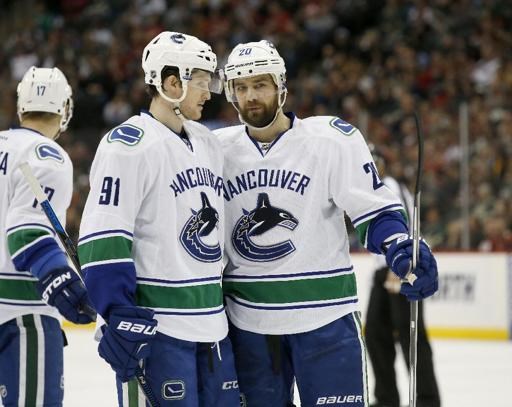Canucks fans all expected to see one of the Canucks’ young forwards step up as the team’s second line centre this season. It’s just that we expected it would be Bo Horvat.
Horvat hasn’t exactly disappointed—he’s taken on tougher minutes this season, particularly in the absence of Brandon Sutter, and he’s shown flashes of offensive brilliance—but he also hasn’t lived up to the expectations set by his stellar finish to his rookie year.
Jared McCann, on the other hand, had no expectations coming into this season. He wasn’t even supposed to make the team out of training camp. If he did, he wasn’t expected to make it past a 9-game audition before heading back to Junior. And if he managed to make it past that, he certainly wasn’t expected to be a key offensive contributor.
At every moment, McCann has exceeded expectations. His ensured he . His five goals in his first nine games ensured he . And now his diligent hard work and developing chemistry with Radim Vrbata and Chris Higgins might mean he’s found the ideal spot for himself in the lineup. And it’s on what looks an awful lot like the second line.
Sure, it might be a little soon to make sweeping proclamations, and my opinion might be skewed by what was easily Jared McCann’s best game of the season Wednesday against the Wild, but it makes a lot of sense.
The Canucks started the season without a typical second line. Instead, they had the Sedins and everyone else. They distributed their skilled youngsters throughout the lineup, handed defensive responsibilities fairly equally between Brandon Sutter and Bo Horvat and bumped up the ice time of physical fourth-liners Derek Dorsett and Brandon Prust whenever Willie Desjardins worried about the kids.
Even still, it’s been clear that, for most of the season, Jared McCann has centred the fourth line. I know that because his most common linemate this season has been Derek Dorsett and whichever line Dorsett is on is the fourth line by default.
That’s not ideal, as Dorsett isn’t exactly offensively gifted and Desjardins is inclined to use him in defensive situations in which he isn’t comfortable using McCann. That limits McCann’s ice time and offensive opportunities and puts him in defensive situations that highlight his weaknesses.
McCann has thrived on an easier deployment as it plays to his strengths. It certainly paid off against the Wild. McCann started a higher percentage of his shifts in the offensive zone in that game than any other Canuck and his line utterly dominated in possession. That’s a switch from earlier in the season.
When he was racking up goals early on, his underlying possession statistics were a serious concern. The worry was that when the goals dried up, his shaky two-way game would cost the team.
The goals did dry up—he has just one goal in his last 12 games—but he hasn’t cost the team anything, because his underlying numbers improved immensely. He’s now 7th among Canucks forwards in even-strength corsi and is above 50%. That’s fantastic for a 19-year-old rookie, even if he’s been somewhat sheltered in order to get there.
Lately, McCann has been primarily starting in the offensive zone and hasn’t been used against the top lines of other teams, but that seems like an appropriate deployment for an offensively-skilled player like McCann who’s still developing his two-way game.
In order to make the most of that deployment, however, he needs linemates that can also make the most of it. Dorsett isn’t that player. Radim Vrbata is.
In the brief time they’ve spent together, McCann and Vrbata have looked good, which is encouraging, as Vrbata himself has struggled to get going this season. The pairing of those two—the brash, confident McCann with the quieter, more reserved Vrbata—may be mutually beneficial. Also, Vrbata hasn't hesitated to boost McCann's ego, . As Andy Samberg as Nicolas Cage would say, .
McCann’s assist on Vrbata’s first goal against the Wild shows the potential: McCann’s zone entry (off a very nice no-look pass from Alex Edler) is very smart, picking up speed and getting ahead of the puck before dragging it forward, creating some nice space for himself on the right wing. He then draws the defender in before finding Vrbata unmarked in the slot with a well-placed backhand pass.
McCann is a scoring threat because of his shot, but adding another goalscorer to his line makes him an even bigger threat, both because it opens up the ice for him to get his shot off and because it gives him an opportunity to showcase his playmaking.
The statistics bear out their early chemistry, with the caveat that they come from a small sample size. McCann and Vrbata have put up a 63.5% corsi in their brief time together, a far cry from McCann’s 46.5% corsi apart from Vrbata.
Chris Higgins helps as well. While many fans are loathe to think of Higgins as a second-line forward, he has consistently scored at a second-line rate in his career. At least, consistent from season-to-season, if not game-to-game.
Where Higgins helps is in puck possession, an area in which he is consistent. Higgins is an excellent two-way forward, which helps a player like McCann significantly. The two together have put up a 62.8% corsi, again aided by deployment—the two have started most of their shifts together in the offensive zone.
Really, there should be no argument that Jared McCann is now the Canucks’ second line centre. Much like whichever line Dorsett is on is the fourth line, whichever line Vrbata is on when he’s not with the Sedins is the second line.
McCann is on Vrbata’s line. Modus ponens.
Ěý
*Statistics from war-on-ice.com and stats.hockeyanalysis.comĚý


